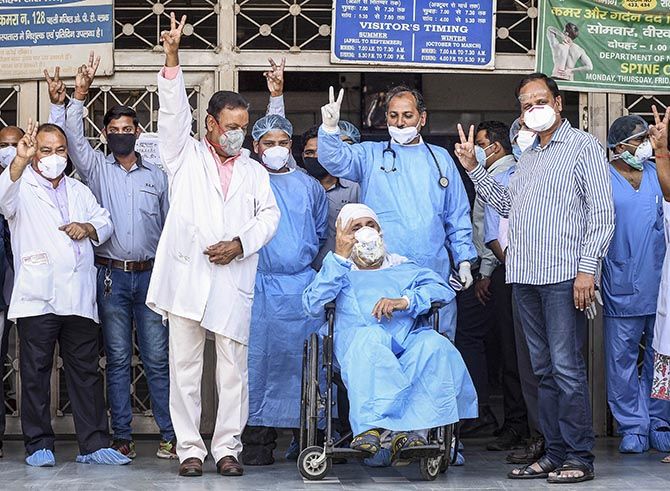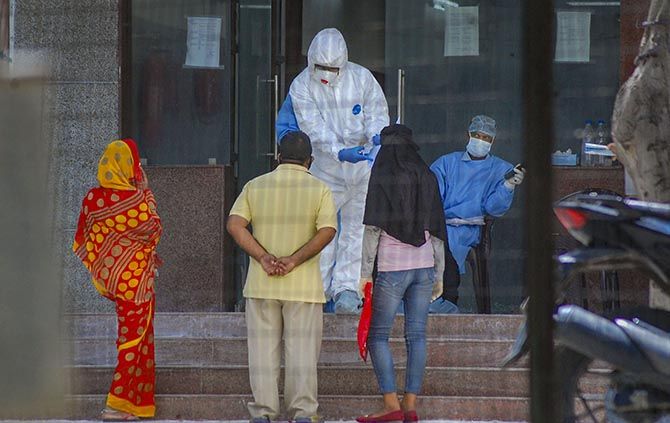'What is hindering us is the fear for the disease.'
'For those below the age of 55 years, it's a mild disease.'
'So take care of yourself, your family and your parents.'

Dr Jayaprakash Muliyil, former principal of the Christian Medical College, Vellore, is one of the country's leading epidemiologists. He has served the Indian Council of Medical Research in various advisory committees in the past and his work involves decades of extensive research in the area of infectious diseases.
"The virus causes a mild disease in people in the younger age group and among those above the age of 60 years, the mortality is high. If you look at the country's population statistics, about 12.5 per cent are above 55 years of age. It means roughly 87.5 per cent are people whom I call young. So if you take care of the elderly and allow the transmission in younger population, but not too fast, just slow down a bit, it can work," Dr Muliyil tells Somesh Jha.
How should the government proceed ahead in the second phase after the current 21-day lockdown period gets over?
The principle of the whole strategy is based on an important recognition, that is by searching cases and isolating them alone, we will not be able to contain it. So the question of containing the virus is out.
What is the next course? The next strategy is to say, ok, infections will continue and we need to take care of people who fall ill and require medical help.
However, there is something uncomfortable about this line of thinking because the spread of virus is going up in an exponential fashion, so we will not be able to take care of people who need health care as the system will be overwhelmed by the number of severely sick who will land up in hospitals.
Now we have to ask, given the circumstances, what do we do? We have to ask: Is there any other way to contain this problem?
In 2009, there was an epidemic of H1N1 influenza. What happened to it? It came in and stayed for two-three months and spontaneously disappeared.
Nothing that we did at the point of time was of help. It went away. Why? It is because of a certain level of herd immunity that was produced by the infection.
So, our only hope is that this virus head that way. Unfortunately, we are not sure what percentage of the population would be infected before we reach that so-called protective level.
From then, it will all come down magically.
But then the problem would be to determine what should be the right ratio. Let's say it's 50 to 60 per cent, but for that we need good data coming from the system and it's vital.
Because in a battle, we cannot fight enemy without information and if it is given to us properly, then we will be able to study.
Now that we have said that, we have to ask: By the time 60 per cent of the population is infected, how many will die?
That will not be an acceptable proposition. Immediately, you will realise there is another solution.
The interesting thing about this disease is that the virus causes a mild disease in people in the younger age group and among those above the age of 60 years, the mortality is high.
If you look at the country's population statistics, about 12.5 per cent are above 55 years of age.
It means roughly 87.5 per cent are people whom I call young. So if you take care of the elderly and allow the transmission in younger population, but not too fast, just slow down a bit, it can work.
Let it happen. Don't do overcrowding, try to keep distance from each other.
Work has to go on, industry has to be restarted, agricultural activities have to start and at the same time, young people will recover from the infection.
When the immunity level is attained to the so-called protective level, or herd immunity, we can say that the epidemic has been seized.
But that doesn't mean it won't come back again. It may come back in another year or so, but by then, we may have a vaccine.
But is it plausible for any government to target 'herd immunity' to counter such a disease?
What is the other solution then? Suggest something else?
Some countries, such as South Korea, did a lot of testing, for instance...
The cost of testing a person for COVID-19 is Rs 4,500. Then, you test everybody -- healthy and unhealthy. Will it be possible to test 1.3 billion people?
The disease is going to be there -- whether you like it or not even if you ramp up your testing. Remember, most of them are sub-clinical cases.
The United Kingdom tried to experiment with 'herd immunity', but didn't seem to quite succeed. What are your views?
The more the mobility, the rate of the infection spread will be higher.
We have to understand how epidemics normally work. When a new viral epidemic comes, people are not immune to it. There will be lower resistance initially.
It goes from person to person and you cannot stop it. And since it's most sub-clinical, it becomes difficult to isolate that person.
But when the virus reaches a particular level of saturation, it automatically stops because it can't find a host. It depends from virus to virus.
For measles, around 90 per cent of the population needs to be vaccinated to achieve herd immunity and for influenza, it is 40 per cent.
But one has to stagger the process of reaching herd immunity and slow down the spread of the infection so that you can handle much more efficiently and not lose too many patients. That's not what the UK did.

But in India, where there is a problem of lack of space, will it be possible to protect the elderly from the younger population?
Keep the elderly in a room and how much distance do we need? Two metres.
You don't need to have social discrimination, but only physical distance. In other words, don't hug your father, keep a distance and let them be there.
There is a possibility that they might still get infected, but it will reduce the spread. In some areas, it will certainly be a problem, like for the elderly people in the slum. But the population in slums is by and large young and middle-aged.
In villages, we do have lack of space and a large number of people still living together under one roof.
You encourage your old men to sleep under trees. It is about what people have to do to devise ways to protect themselves and their families.
Don't militate. Let them do it. We are a democracy. People have the right to do what they want.
Can we stop the disease from spreading? No. Now, it will reach an exponential phase and the fact is that even where you slow it down and you don't have protection within the community, known to be herd immunity; it will come back.
The current strategy of a lockdown was to ensure that we 'flatten the curve' and buy time for adequate medical facilities to be in place. Do you think this has helped us?
We did a short strategy for three weeks, advised by some people. We tested it out.
During this period, at least people have learned that there is a disease known as the coronavirus that exists and they have learnt how to protect themselves, by keeping a distance. They have realised crowds are bad for health now.
In three weeks, we were able to educate the nation. We have probably bought ourselves a few extra weeks for the disease to exponentially rise.
But it will come back when people will start moving and there will be contacts. We can't do anything about it.
We cannot run away to the moon. Can we?
There is a virus, there are people and the only way to protect is the way you behave to some extent.
One more thing, if you get the infection once, you are protected forever.
When the national lockdown comes to an end, what should we do?
There will be more cases. We will have to look after them.
Even if we don't have ventilators, we will be able to give some support through oxygen. We need to remember that our health system is not as advanced as the United States.
If they are suffering, how much more will we suffer? No wishful thinking.
Ventilator, you know, requires a lot of expertise to manage. We will have a problem of training people.
I think what is hindering us is the fear for the disease. For those below the age of 55 years, it's a mild disease.
We will lose a few, but that will be a small percentage.
In older people, the mortality will be higher. So take care of yourself, your family and your parents. That's the basic principle.
So you are suggesting that the lockdown should be lifted and people be allowed to go back to their lives?
I told you a framework. We have to decide: How crowded can the buses be? Can we have a cricket match?
Even when we go back to a normal lifestyle, you cannot afford the rush of cases. You need to slow it down.
There should be a kind of understanding that there will be a continued infection, however, the days of eradicating it is gone.
We have to achieve herd immunity. In building it up, we have to reduce mortality by keeping the elderly people away.











